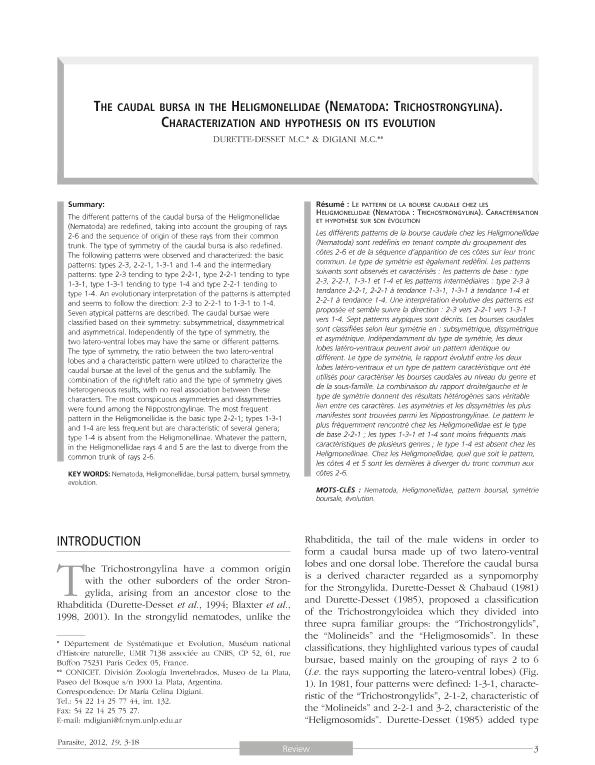Artículo
The different patterns of the caudal bursa of the Heligmonellidae (Nematoda) are redefined, taking into account the grouping of rays 2-6 and the sequence of origin of these rays from their common trunk. The type of symmetry of the caudal bursa is also redefined. The following patterns were observed and characterized: the basic patterns: types 2-3, 2-2-1, 1-3-1 and 1-4 and the intermediary patterns: type 2-3 tending to type 2-2-1, type 2-2-1 tending to type 1-3-1, type 1-3-1 tending to type 1-4 and type 2-2-1 tending to type 1-4. An evolutionary interpretation of the patterns is attempted and seems to follow the direction: 2-3 to 2-2-1 to 1-3-1 to 1-4. Seven atypical patterns are described. The caudal bursae were classified based on their symmetry: subsymmetrical, dissymmetrical and asymmetrical. Independently of the type of symmetry, the two latero-ventral lobes may have the same or different patterns. The type of symmetry, the ratio between the two latero-ventral lobes and a characteristic pattern were utilized to characterize the caudal bursae at the level of the genus and the subfamily. The combination of the right/left ratio and the type of symmetry gives heterogeneous results, with no real association between these characters. The most conspicuous asymmetries and dissymmetries were found among the Nippostrongylinae. The most frequent pattern in the Heligmonellidae is the basic type 2-2-1; types 1-3-1 and 1-4 are less frequent but are characteristic of several genera; type 1-4 is absent from the Heligmonellinae. Whatever the pattern, in the Heligmonellidae rays 4 and 5 are the last to diverge from the common trunk of rays 2-6. Les différents patterns de la bourse caudale chez les Heligmonellidae (Nematoda) sont redéfinis en tenant compte du groupement des côtes 2-6 et de la séquence d’apparition de ces côtes sur leur tronc commun. Le type de symétrie est également redéfini. Les patterns suivants sont observés et caractérisés : les patterns de base : type 2-3, 2-2-1, 1-3-1 et 1-4 et les patterns intermédiaires : type 2-3 à tendance 2-2-1, 2-2-1 à tendance 1-3-1, 1-3-1 à tendance 1-4 et 2-2-1 à tendance 1-4. Une interprétation évolutive des patterns est proposée et semble suivre la direction : 2-3 vers 2-2-1 vers 1-3-1 vers 1-4. Sept patterns atypiques sont décrits. Les bourses caudales sont classifiées selon leur symétrie en : subsymétrique, dissymétrique et asymétrique. Indépendamment du type de symétrie, les deux lobes latéro-ventraux peuvent avoir un pattern identique ou différent. Le type de symétrie, le rapport évolutif entre les deux lobes latéro-ventraux et un type de pattern caractéristique ont été utilisés pour caractériser les bourses caudales au niveau du genre et de la sous-famille. La combinaison du rapport droite/gauche et le type de symétrie donnent des résultats hétérogènes sans véritable lien entre ces caractères. Les asymétries et les dissymétries les plus manifestes sont trouvées parmi les Nippostrongylinae. Le pattern le plus fréquemment rencontré chez les Heligmonellidae est le type de base 2-2-1 ; les types 1-3-1 et 1-4 sont moins fréquents mais caractéristiques de plusieurs genres ; le type 1-4 est absent chez les Heligmonellinae. Chez les Heligmonellidae, quel que soit le pattern, les côtes 4 et 5 sont les dernières à diverger du tronc commun aux côtes 2-6.
The caudal bursa in the Heligmonellidae (Nematoda: Trichostrongylina): Characterization and hypothesis on its evolution
Título:
Le pattern de la bourse caudale chez les Heligmonellidae (Nematoda: Trichostrongylina): Caractérisation et hypothèse sur son évolution
Fecha de publicación:
02/2012
Editorial:
Princeps Editions
Revista:
Parasite - Journal de la Société Française de Parasitologie
ISSN:
1252-607X
Idioma:
Inglés
Tipo de recurso:
Artículo publicado
Clasificación temática:
Resumen
Palabras clave:
Bursal Pattern
,
Bursal Symmetry
,
Evolution
,
Heligmonellidae
,
Nematoda
Archivos asociados
Licencia
Identificadores
Colecciones
Articulos(CCT - LA PLATA)
Articulos de CTRO.CIENTIFICO TECNOL.CONICET - LA PLATA
Articulos de CTRO.CIENTIFICO TECNOL.CONICET - LA PLATA
Citación
Durette Desset, M. C.; Digiani, Maria Celina; The caudal bursa in the Heligmonellidae (Nematoda: Trichostrongylina): Characterization and hypothesis on its evolution; Princeps Editions; Parasite - Journal de la Société Française de Parasitologie; 19; 1; 2-2012; 3-18
Compartir
Altmétricas




